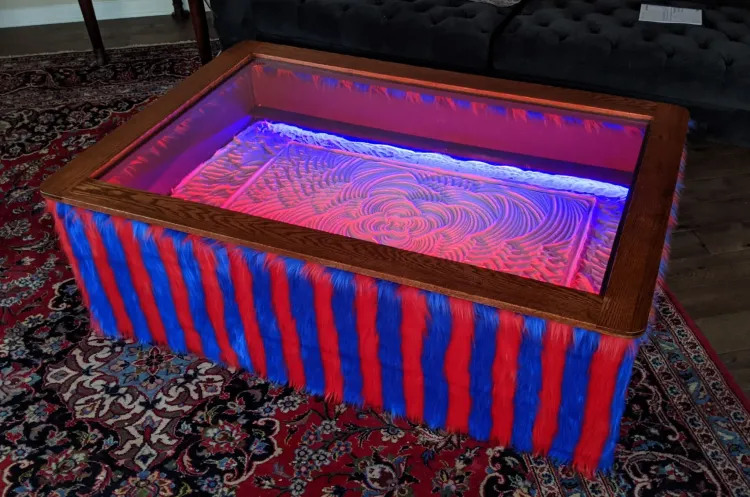Enter Arrakis: The Galaxy's Fastest Sand Table
Mark Rehost is a maker/engineer, community health worker, and member of Milwaukee Makerspace. He's also, clearly, a fan of Frank Herbert's epic Dune. This weekend at Maker Faire Milwaukee, he'll be showcasing his second-generation Arrakis sand table following his original foray into intricate patterns in sand, The Spice Must Flow, both of which create sandworm-worthy patterns. /p>
Says Mark of his journey to Arrakis: I was born an engineer and pursued a career in engineering from an early age. In high school, I was a member of the Explorer Post 373 ham radio that met at Bay View United Methodist Church, a few blocks from one of the Milwaukee Makerspace locations today. I eventually earned an electrical engineering degree from UW Milwaukee in 1981 and embarked on a career that took me to Illinois, California, Japan, and Texas. After 22 years at Motorola, Hewlett-Packard, Fujitsu Microelectronics, and Texas Instruments, corporate engineering and I had grown tired of each other, and at 46 I decided to reinvent myself. Six years of school followed, and in 2011, at the tender age of 52, I graduated from the Arizona School of Dentistry and Oral Health. In 2012 I moved back to the Milwaukee area to work in a community health clinic and soon joined the Milwaukee Makerspace. For the past five years, I have worked at Vivent Health, an organization that cares for HIV patients.
Work has always interfered with my engineering projects from home, and when I became a dentist, working only four days a week freed up an extra day for projects. My first project at Makerspace was to design and build a 3D printer much larger than the kits available at the time. Over the next few years, I designed and built two more printers and managed the Makerspace 3D printing area.
I used the knowledge of 3D printing mechanisms and electronics I learned at Makerspace to design and build my first sand table, The Spice Must Flow, to be exhibited at MakerFaire Milwaukee 2018. There was lots of 3D printed parts in the mechanism. After this first success, I wanted to reduce the noise, increase the speed and integrate the mechanism into a piece of furniture that I could use in my living room. The Arrakis sand table that can be seen at MakerFaire Milwaukee this year is the result.
He describes how existing parts were used to create this unique piece of art for Maker Faire Milwaukee 2018 in Hackday and in a detailed blog post that serves as a project template: This is a project that contains many ready-to-use electronic devices. and open source software to control the mechanism. Unlike most other sand tables you may have seen on the web, this one is powered by servo motors that allow for insane speed and acceleration, operating at very low to low noise levels, even at speeds high. The table uses a redesigned and 3D printed corexy mechanism with sliding PTFE bearings to move a neodymium magnet that pulls a steel ball through a thin layer of sand, leaving interesting patterns behind. The patterns are illuminated from low angle by strips of red and blue LEDs, illuminating red ridges on one side and blue on the other, with dark shadows in the valleys between the ridges.
The best way to get an idea of Rehost's process from start to finish is to head over to his blog, where he detailed his inspiration, design, technical steps, and changes over the years. successive iterations.


Mark Rehost is a maker/engineer, community health worker, and member of Milwaukee Makerspace. He's also, clearly, a fan of Frank Herbert's epic Dune. This weekend at Maker Faire Milwaukee, he'll be showcasing his second-generation Arrakis sand table following his original foray into intricate patterns in sand, The Spice Must Flow, both of which create sandworm-worthy patterns. /p>
Says Mark of his journey to Arrakis: I was born an engineer and pursued a career in engineering from an early age. In high school, I was a member of the Explorer Post 373 ham radio that met at Bay View United Methodist Church, a few blocks from one of the Milwaukee Makerspace locations today. I eventually earned an electrical engineering degree from UW Milwaukee in 1981 and embarked on a career that took me to Illinois, California, Japan, and Texas. After 22 years at Motorola, Hewlett-Packard, Fujitsu Microelectronics, and Texas Instruments, corporate engineering and I had grown tired of each other, and at 46 I decided to reinvent myself. Six years of school followed, and in 2011, at the tender age of 52, I graduated from the Arizona School of Dentistry and Oral Health. In 2012 I moved back to the Milwaukee area to work in a community health clinic and soon joined the Milwaukee Makerspace. For the past five years, I have worked at Vivent Health, an organization that cares for HIV patients.
Work has always interfered with my engineering projects from home, and when I became a dentist, working only four days a week freed up an extra day for projects. My first project at Makerspace was to design and build a 3D printer much larger than the kits available at the time. Over the next few years, I designed and built two more printers and managed the Makerspace 3D printing area.
I used the knowledge of 3D printing mechanisms and electronics I learned at Makerspace to design and build my first sand table, The Spice Must Flow, to be exhibited at MakerFaire Milwaukee 2018. There was lots of 3D printed parts in the mechanism. After this first success, I wanted to reduce the noise, increase the speed and integrate the mechanism into a piece of furniture that I could use in my living room. The Arrakis sand table that can be seen at MakerFaire Milwaukee this year is the result.
He describes how existing parts were used to create this unique piece of art for Maker Faire Milwaukee 2018 in Hackday and in a detailed blog post that serves as a project template: This is a project that contains many ready-to-use electronic devices. and open source software to control the mechanism. Unlike most other sand tables you may have seen on the web, this one is powered by servo motors that allow for insane speed and acceleration, operating at very low to low noise levels, even at speeds high. The table uses a redesigned and 3D printed corexy mechanism with sliding PTFE bearings to move a neodymium magnet that pulls a steel ball through a thin layer of sand, leaving interesting patterns behind. The patterns are illuminated from low angle by strips of red and blue LEDs, illuminating red ridges on one side and blue on the other, with dark shadows in the valleys between the ridges.
The best way to get an idea of Rehost's process from start to finish is to head over to his blog, where he detailed his inspiration, design, technical steps, and changes over the years. successive iterations.

What's Your Reaction?






















